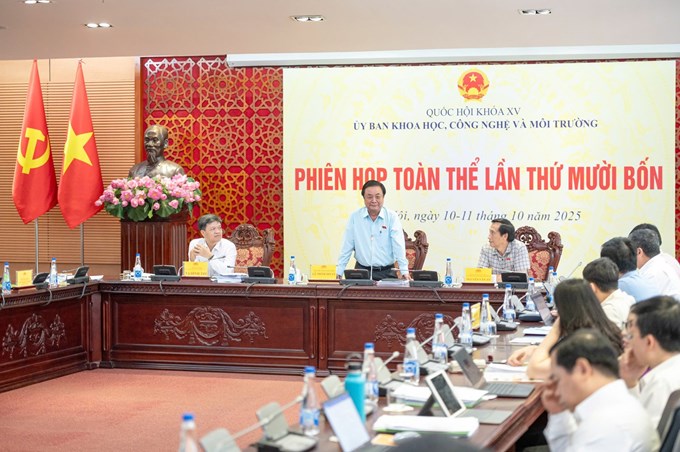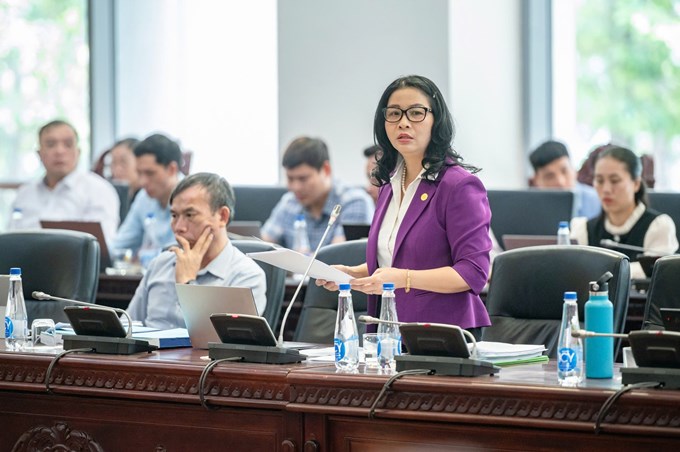At the 14th plenary session of the National Assembly’s Committee on Science, Technology and Environment, delegates discussed and contributed opinions on the Draft Laws amending and supplementing certain provisions of 15 Laws in the fields of agriculture and environment.
Speaking at the session, Professor Dr. Nguyen Thi Lan, President of Vietnam National University of Agriculture (VNUA) and a member of the Hanoi National Assembly Delegation, emphasized that the amendment of these laws was essential to ensure alignment with the two-tier administrative system, streamline the state apparatus, enhance decentralization and delegation of authority, and concretize the latest Party and Politburo resolutions on the development of science-technology, the green economy, circular economy, and digital transformation.
Regarding Article 15 of the Draft Law, which amended certain provisions of the 2018 Law on Crop Production, Prof. Lan noted that the draft demonstrated a clear direction toward improving the institutional framework for managing crop varieties, fertilizers, planting area codes, and product traceability, thereby meeting the requirements of modern, transparent, and internationally integrated agriculture.
However, she pointed out that several contents still needed clarification and supplementation to ensure feasibility and strengthen management capacity and quality control in the crop production sector.

Vice Chairman of the National Assembly Le Minh Hoan chairs the 14th plenary session of the Committee on Science, Technology and Environment. Photo: quochoi.vn.
According to Prof. Lan, VNUA’s President, regarding the management of crop varieties and fertilizers, while the draft law provided detailed regulations on violations and production/business conditions — which were necessary for tightening governance — it should also add the role of agricultural training and research institutions in independent testing and evaluation of seed and fertilizer quality. “In many countries such as Japan, South Korea, and the Netherlands, agricultural universities are officially recognized by the State as national reference laboratories with the function of independent inspection, monitoring, and technical evaluation.
This mechanism not only helps reduce the administrative burden and increase objectivity but also facilitates the rapid incorporation of scientific advances into practical management.
If Vietnam adopted this regulation, it would establish a legal foundation to mobilize scientific expertise in monitoring the quality of agricultural inputs”, Prof. Lan emphasized.
Concerning Clause 2, Article 15, on the recognition and renewal of circulation permits for crop varieties, the draft extended the duration to 20 years for annual crops and 25 years for perennial crops, with an option for renewal.
Prof. Lan agreed with this direction, noting that it encouraged investment in plant breeding. However, she proposed that the renewal process should be based on periodic evaluations of yield, genetic stability, adaptability, and environmental impact, to be conducted by designated research and training institutions under the Ministry.
Such a mechanism, she said, would ensure scientific transparency and prevent the prolonged circulation of degraded varieties that could reduce productivity and harm the reputation of Vietnamese agricultural products.
Regarding Article 40, which outlined the conditions for fertilizer testing, Prof. Lan recommended adding two provisions: (i) First, the Ministry of Agriculture and Environment should publicly disclose the list of authorized testing organizations and periodically re-evaluate their competence; (ii) Second, research institutes and universities with laboratories certified under ISO/IEC 17025 should be allowed to participate in the national fertilizer testing network.

Prof. Dr. Nguyen Thi Lan, VNUA’s President, gives her recommendations at the meeting. Photo: quochoi.vn
“Vietnam can leverage existing resources from research institutes and leading agricultural universities such as VNUA, Can Tho University, and Nong Lam University – Ho Chi Minh City, which possess strong scientific capabilities and internationally qualified experts. These universities can serve as key technical partners in supporting the Ministry with testing and quality supervision of fertilizers and agricultural inputs,” she said.
On Article 42, concerning fertilizer trading conditions, the draft required traders to undergo professional training or possess at least an intermediate-level qualification in a relevant field. Prof. Lan praised this progressive provision but suggested establishing a professional licensing system and continuing professional development (CPD) program for fertilizer traders to ensure compliance.
For Article 64, on planting area codes and packaging facilities, Prof. Lan welcomed the direction toward digitalization and traceability, in line with international trends. She proposed developing a national database on planting areas managed by the Ministry of Agriculture and Environment, connected directly to the Customs Department, Department of Crop Production and Plant Protection, and major export markets. At the same time, research institutes and universities should be allowed to participate in technical assessments of planting areas, evaluation of GAP (Good Agricultural Practices) standards, and chemical residue analysis.
“I believe the draft law should explicitly define the role of universities and research institutes in the national crop management system. These institutions not only train human resources but also act as crucial technical partners in seed research, fertilizer testing, quality evaluation, and policy consultation. This approach would help Vietnam harness domestic intellectual resources, enhance policy feedback, and integrate science and technology into policy governance and monitoring”, Prof. Lan said.
VNUA’s President proposed adding a provision on the role of universities and research institutes in the national crop management system. These institutions not only trained human resources but also served as key technical partners in seed research, fertilizer testing, quality assessment, and policy consultation.
On the issue of agricultural land management and use, Prof. Lan stressed the importance of protecting the topsoil layer of paddy fields, which determines fertility, productivity, and the self-restoration capacity of Vietnam’s farmlands.
While existing regulations, such as the 2013 Land Law, Decree 35/2015/ND-CP, and Decree 62/2019/ND-CP, mentioned stripping, storing, and restoring topsoil when converting rice land for other purposes, they remained lacking in technical detail, national standards, unified databases, and effective monitoring mechanisms.
“In many localities, during infrastructure projects, the topsoil, which had formed over centuries of cultivation, was removed and lost, causing irreversible degradation, reduced soil fertility, and long-term threats to food security,” she warned.
Countries such as Japan, China, Thailand, and the European Union treated topsoil as a strategic national resource, setting clear standards for minimum thickness, mandatory removal–storage–restoration during construction, regular monitoring of pH and organic matter, and national digital soil mapping. Some countries even maintained Topsoil Restoration Funds to rehabilitate degraded lands.
In practice, the implementation in Vietnam still faced several difficulties and inconsistencies in regulations. When infrastructure projects were carried out on converted rice land, the processes of stripping, storing, and restoring the topsoil were clearly guided; in some cases, there was even no designated area to deposit this soil, which could lead to project delays.
Prof. Lan proposed that the drafting committee develop specific sub-law documents to ensure consistency, facilitate implementation for businesses and local authorities, and protect this invaluable, strategic resource — the topsoil of rice-growing areas.
She also proposed five key solutions: (i) First, issue National Technical Standards on Topsoil, specifying thickness, removal, storage, and restoration procedures; (ii) Second, build a national database on paddy topsoil, to be updated every five years; (iii) Third, clearly assign responsibility to provincial Departments of Agriculture and Environment for supervision, restoration, and regular reporting; (iv) Fourth, allocate part of the Rice Land Protection and Development Fund to finance soil rehabilitation and restoration activities; (v) Finally, encourage research institutes and universities to conduct independent monitoring, scientific assessments, and technology transfer for soil conservation.
“Protecting the topsoil is not merely preserving a thin layer of earth, it is safeguarding the ‘soul of the rice fields’, the foundation of food security and sustainable agriculture. I urge the drafting committee to give this issue due consideration,” Prof. Lan concluded.